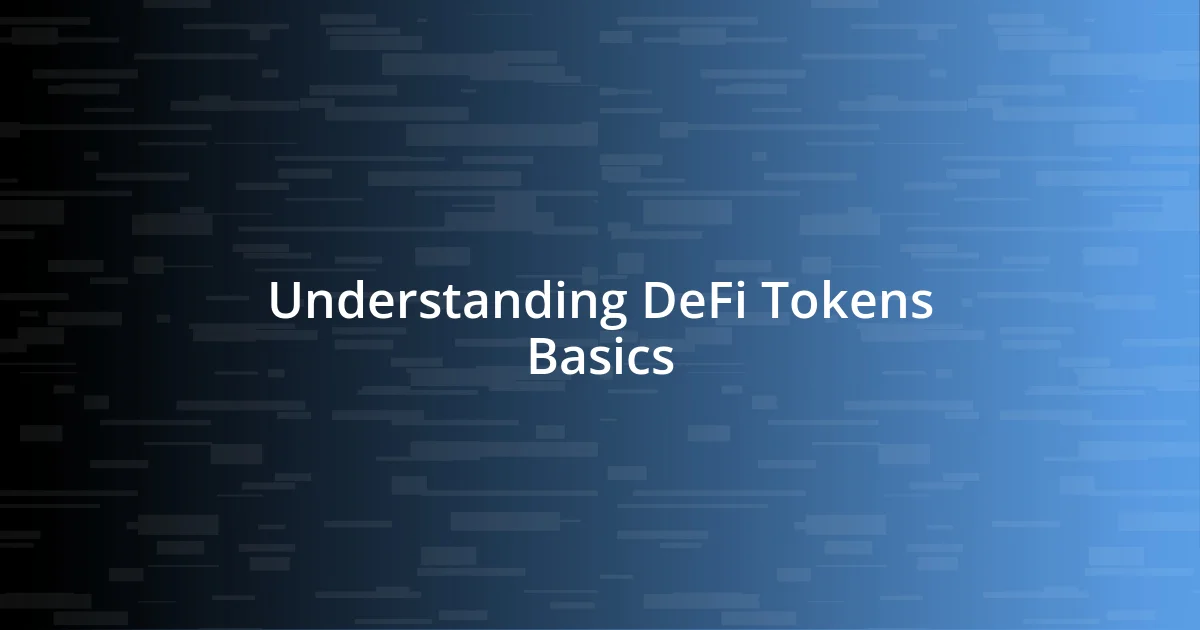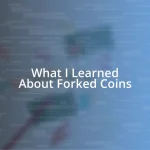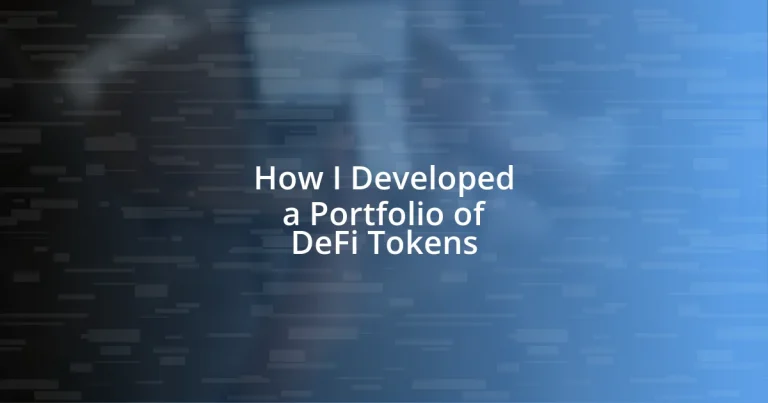Key takeaways:
- DeFi tokens empower users by enabling control over finances without intermediaries, offering transparency and earning potential through staking.
- Effective research involves analyzing whitepapers, engaging with communities, and monitoring token market performance for informed investment decisions.
- Risk management is crucial in DeFi; diversification across different projects and awareness of community dynamics can help mitigate potential losses.

Understanding DeFi Tokens Basics
DeFi tokens represent a revolutionary shift in how we interact with finance, allowing users to trade, lend, and earn interest without intermediaries. I remember my first foray into DeFi; I was both excited and overwhelmed by the sheer number of options available. It felt like being a kid in a candy store—so many remarkable possibilities, but which one to choose?
What truly fascinates me about DeFi tokens is their underlying technology, primarily blockchain. These tokens can add real value to both individual users and the broader financial ecosystem by providing transparency and security. Have you ever thought about how empowering it is to have the ability to control your own finances? This decentralized approach gives everyone access to services that were previously limited to traditional institutions.
Moreover, DeFi tokens can often yield rewards through staking and liquidity provision. I recall the first time I staked my crypto; the anticipation of earning passive income felt almost surreal. It’s thrilling to see your assets working for you, isn’t it? Understanding these basic principles of DeFi tokens is essential for anyone looking to delve deeper into this vibrant space.

Researching DeFi Projects Effectively
When diving into DeFi projects, I find that a systematic approach to research makes all the difference. I often start by exploring project whitepapers, which provide a wealth of information about the project’s vision, technology, and team behind it. It’s like reading the blueprint of a building—you get to understand its core structure. One time, I spent hours analyzing a project’s whitepaper only to discover some glaring red flags, which ultimately saved me from making a poor investment.
Community engagement is another crucial aspect to consider. I usually check forums, social media channels, and Discord groups to gauge the sentiment around a project. I’ve found that active and positive community discussions often indicate a project’s potential for growth. In fact, during my research on a certain token, the enthusiasm of the community members not only inspired me but also gave me confidence in the investment. Conversely, a project lacking community support has often been a telltale sign for me to steer clear.
Lastly, I always keep an eye on the token’s market performance and historical data. Patterns can reveal a lot—are they moving with the market trends or defying them? In my experience, understanding market cycles has helped me make wiser decisions. I remember noticing a token that consistently gained traction even during downturns, prompting me to take a closer look and, ultimately, invest successfully.
| Research Aspect | Importance |
|---|---|
| Whitepapers | Provides foundational knowledge about vision and technology |
| Community Engagement | Indicates project sentiment and potential growth |
| Market Performance | Reveals historical trends and informs investment timing |

Analyzing Tokenomics for Investment
When it comes to investing in DeFi tokens, analyzing tokenomics is a crucial step that I never overlook. Tokenomics refers to the economic model around a token, including its supply, distribution, and utility within the project. For instance, I remember the first time I delved into the tokenomics of a project; understanding the maximum supply and how tokens were allocated made me realize the importance of scarcity and potential inflation. Discovering a project with a well-thought-out tokenomics structure can often be the key to predicting its long-term sustainability and success.
To effectively analyze tokenomics, I focus on several key factors:
- Total Supply: What is the maximum number of tokens that will ever exist? A limited supply can enhance value.
- Distribution Model: How are tokens distributed among investors, team members, and the community? Equitable distribution often indicates a healthier project.
- Utility: What functions does the token serve? Tokens that provide governance rights or staking rewards may hold more intrinsic value.
- Incentives: Are there mechanisms in place to encourage holding or using the token rather than just speculating? Projects with clear incentives often foster stronger communities.
Reflecting on past investments, I’ve found that tokens with robust tokenomics can weather market volatility better than those without. It’s always a good feeling when my analysis pays off, and I see my investment flourish.

Diversifying Your DeFi Holdings
Diversifying your DeFi holdings is like creating a balanced diet—you want a variety of tokens to mitigate risks. In my experience, I learned the hard way that concentrating too much in one area can be detrimental. I once had almost all my investments in a single token that plummeted overnight due to regulatory concerns. The sudden drop left me scrambling, a feeling I wouldn’t wish on anyone. After that, I made it a point to spread my investments across different projects.
The key to effective diversification, in my opinion, is choosing tokens from various sectors within DeFi—like lending, decentralized exchanges, and stablecoins. I remember a phase when I dabbled in yield farming while also holding stablecoins for stability. This mix not only cushioned my portfolio during volatile moments but also provided opportunities for growth in booming sectors. It felt rewarding to see how a diverse portfolio could weather the storm while still reaping rewards.
I’ve also found that keeping an eye on emerging projects can be an exciting way to enhance diversity. A few months ago, I stumbled upon a promising cross-chain token that was generating buzz in DeFi circles. Although I was initially hesitant, my curiosity led me to invest a small portion. That decision paid off big time when the project’s unique value proposition gained traction. It reinforced my belief that diversification can lead to unexpected opportunities and growth.

Setting Up Your Crypto Wallet
Setting up a crypto wallet can be a transformative step in your DeFi journey. Personally, I was initially overwhelmed by the technicalities, but I quickly realized the rewards that came with it. The first wallet I set up was a hot wallet, which allowed me to easily access my tokens and engage in transactions. While it was convenient, I learned that added security measures were important to prevent unwanted breaches.
Once I felt comfortable with the basics, I decided to create a cold wallet as well. This decision gave me a sense of peace, knowing my investments were stored offline, away from potential online threats. It’s fascinating how having both types of wallets can create a balance in your approach—wouldn’t you agree? The act of moving tokens between wallets became not just routine but a little empowering. It made me feel in control of my assets.
Throughout my experience, I’ve also discovered the importance of backing up your wallet. On one occasion, I almost lost access to my tokens due to a forgotten password. The anxiety was palpable! I immediately set up a secure method for recovery that gave me back that peace of mind. I recommend writing down your seed phrase and keeping it in a safe place. After all, you want to avoid that sinking feeling of losing what you’ve worked hard to earn.

Tracking Your Portfolio Performance
Tracking your portfolio performance in DeFi can be as engaging as it is necessary. Personally, I’ve found that using tracking tools like Blockfolio or CoinGecko really helps me visualize my investments. It’s almost satisfying to see those charts update in real-time; they provide a sense of control over my financial journey.
In my experience, setting specific goals for each token has also made a substantial difference. For example, when I invested in a lending protocol, I aimed for a specific interest rate that I hoped to reach. This helped me determine when it made more sense to hold or sell. Have you ever thought about how setting targets can shape your investment strategy? It creates a clearer narrative around your assets and the decisions you make.
Moreover, regularly reviewing my performance helped me learn from my mistakes. I once overcommitted to a token only to see it stagnate for months. Reflecting on that experience taught me the importance of addressing underperformers sooner rather than later. This ongoing assessment not only keeps my portfolio sharp but also equips me with insights to inform my future trades.

Managing Risks in DeFi Investments
Managing risks in DeFi investments is a crucial aspect that I’ve come to embrace over time. I remember when I first dipped my toes into liquidity pools; the appeal of earning passive income was tempting. However, my excitement was quickly met with the reality of impermanent loss. This phenomenon, where the value of your tokens in a liquidity pool can drop relative to holding them, was a painful lesson, reminding me to conduct thorough research before jumping in.
Another area I focus on is diversification. When I started building my portfolio, I was tempted to go all-in on one popular token. Thankfully, a more seasoned friend advised against this, encouraging me to spread my investments across different projects. This not only mitigated my risk but also allowed me to learn about various protocols and their unique features. Have you considered how diversifying your investments can impact your peace of mind? It’s like putting your eggs in different baskets, reducing the chances of losing everything with just one failure.
Lastly, keeping an eye on the community and the team behind any DeFi project has proven invaluable. I vividly recall a conversation I had in a Discord chat about a promising project, which ultimately led me to uncover some red flags regarding the team’s transparency. Being involved in the community not only keeps you informed but also connects you with like-minded individuals who can share insights on potential risks. So, does being part of these communities help in creating a safety net for your investments? Absolutely—it fosters a sense of vigilance that can safeguard your assets.














